The foods and drinks we love every day have interesting histories. Food History, Culinary Origins, Cultural Gastronomy, and Traditional Recipes tell us how they came to be. These stories range from accidental finds to wartime needs, showing how our favorite treats evolved.
In this article, we’ll explore the origins of common items. We’ll see how different cultures and innovations have shaped our food and drinks. From potato chips to cheese puffs, these stories are full of surprises and insights into our culinary world.
Let’s dive into the Culinary Origins and Cultural Gastronomy of our snacks and drinks. Get ready to be amazed, curious, and delighted by the Traditional Recipes and Food History that make our flavors and traditions special.
The Surprising History of Potato Chips
Potato chips are a favorite snack with a rich history. They were first made by George Crum, a chef of African-American and Native American descent. He created them in 1853 at Moon’s Lake House in Saratoga Springs, New York.
The Invention of the First Chip
Legend says Crum made the chips to please a customer who didn’t like his French fries. Crum kept slicing the potatoes until they were thin and golden. To his surprise, people loved them, and he started his own restaurant, “Crumbs House,” to serve them.
Snack Revolution: Chips in Popular Culture
Potato chips quickly became a hit, changing the snack world. In the 1920s, big brands like Lay’s and Fritos started making chips for everyone. By then, over 40,000 candy bars were being made, showing how much people loved easy snacks.
Today, Americans eat about 1.2 billion pounds of potato chips every year. From their accidental start to being a favorite snack, potato chips are a big part of American food culture.
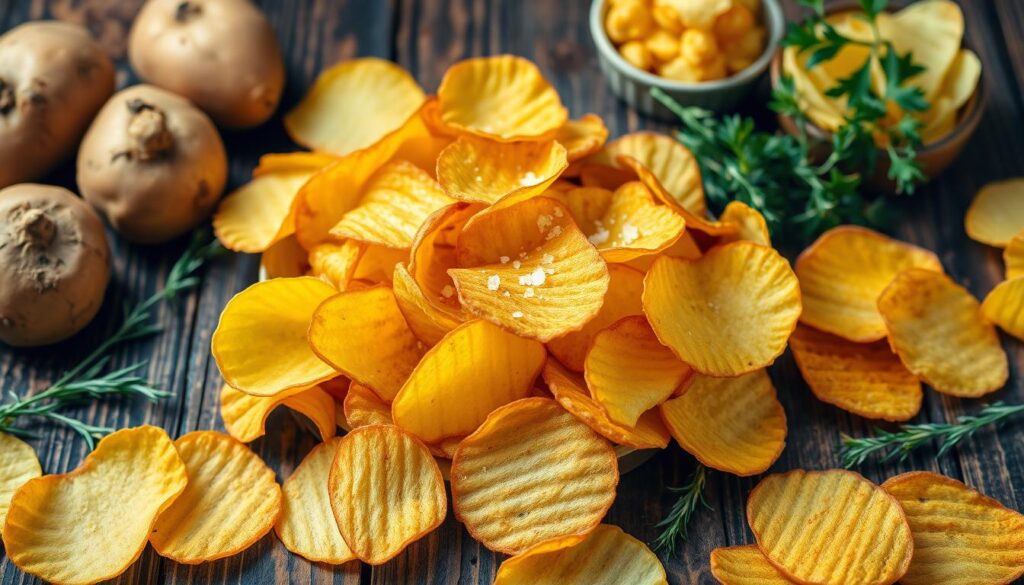

“Potato chips were rumored to have aphrodisiac qualities due to historical mystical beliefs about the potato’s powers.”
The love for potato chips has only grown, with the U.S. industry now worth $10 billion. Now, you can find everything from classic salted chips to chili and chocolate flavors. The potato chip has become a global favorite.
The Evolution of Chocolate Bars
Chocolate’s history is fascinating, tracing back to ancient Mesoamerica. The Food Anthropology of chocolate shows how it changed from a bitter drink to a favorite treat today. The story of the chocolate bar is filled with creative changes over the years.
From Ancient Treats to Modern Confection
Cacao beans, chocolate’s main ingredient, were first found on ancient Olmec pots around 1500 B.C. The Aztecs loved cacao beans so much, they used them as money. They thought they were more valuable than gold.
When chocolate came to Europe in the late 1500s, it quickly became a favorite. The 19th century was a big change for chocolate bars. In 1828, Dutch chemist Coenraad van Houten made powdered chocolate, making it easier to make and sell. Then, in 1876, Swiss chocolatier Daniel Peter made the first milk chocolate bar. The invention of the conching machine by Rudolf Lindt in 1879 also improved chocolate’s taste and texture.
Key Players in the Chocolate Industry
- 1868: Cadbury introduces its first chocolate bar in the UK.
- 1875: Daniel Peter of Switzerland adds milk to chocolate, creating the first milk chocolate bar.
- 1900: The Hershey Chocolate Company in the United States revolutionizes the chocolate industry with mass production techniques, making chocolate bars affordable for the masses.
- 1930s: The Kit Kat bar is introduced in the UK, featuring layers of crispy wafer covered in chocolate.
- 1970s: Dark chocolate bars gain popularity for their health benefits and distinct flavor.
- 2000s: Artisanal chocolate bars and craft chocolate makers such as YummyComb emerge, offering a wide range of unique flavors and cacao bean varieties.
Today, the chocolate industry keeps growing, with more focus on sustainable and fair cacao production. The Food Anthropology, Culinary Heritage, and Flavor Narratives of chocolate continue to evolve. The chocolate bar remains a favorite treat worldwide, loved for its taste and versatility.
The Journey of Soda Pop
The story of soda pop is filled with Food History, Culinary Origins, and Gastronomic Evolution. It starts in ancient Sumeria and ends with today’s global brands. This journey is full of innovation, competition, and cultural impact.
The Birth of Carbonated Beverages
In the 6th century BC, Sumeria began experimenting with carbonated water. This early work set the stage for modern soda pop. In the 18th century, scientists like Joseph Priestley and Johann Schweppe refined carbonation. They created mineral waters and products like Schweppes.
Iconic Brands that Shaped the Industry
In the late 19th century, two giants emerged: Coca-Cola and Pepsi-Cola. Coca-Cola was created by John Pemberton in 1886, and Pepsi-Cola by Caleb Bradham in 1893. These brands fought in the “Cola Wars,” winning over consumers worldwide. Their marketing, like the Pepsi Generation campaign, left a lasting impact on soda pop.
The soda industry has grown, with new flavors, diet options, and health choices. Today, soda reflects changing tastes and environmental awareness. Despite this, soda pop remains a beloved part of our culture, captivating new generations with its unique charm.
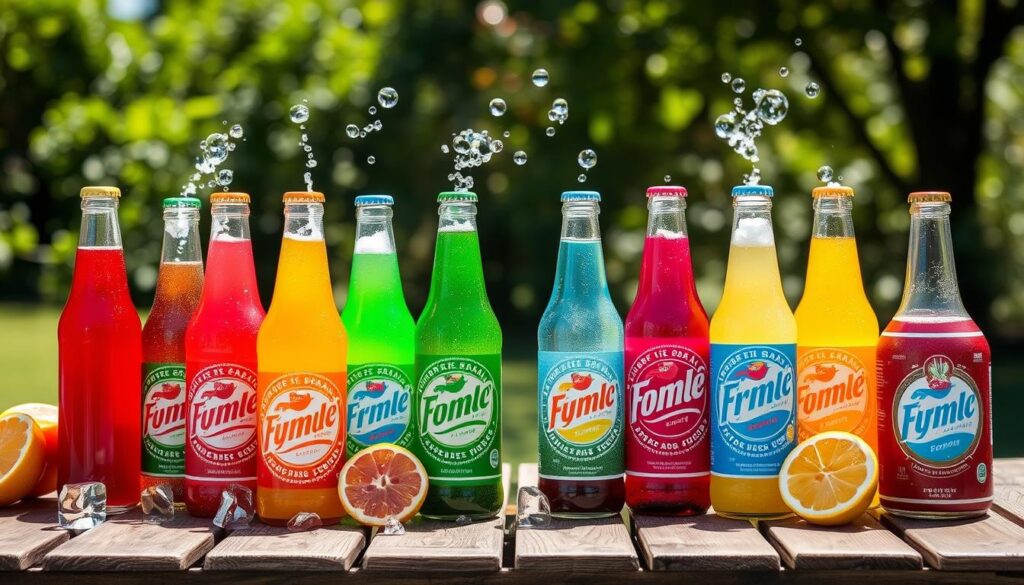

“Soda pop has always been more than just a beverage – it’s a symbol of culture, a connection point, and a testament to the ingenuity of human innovation.”
The Unexpected Roots of Popcorn
Popcorn has a rich history that goes back thousands of years. Archaeologists found 6,700-year-old popcorn cobs in Peru. It was a favorite snack among Native American communities, who shared it with European colonists.
Ancient Origins: From Grain to Snack
The Zea mays variety everta, a special type of corn, is behind popcorn. These kernels have 14–20% moisture. When heated, they expand up to 50 times, turning into the fluffy snack we love.
The traditional recipes and foodways of indigenous people helped shape popcorn. It became a key part of their cultural gastronomy.
Popcorn in Modern Cinema
In the 19th century, popcorn became more popular. Charles Cretors invented the first popcorn machine in 1885. This made popcorn easier to make and sell.
During the Great Depression, popcorn became a favorite at movie theaters. It was an affordable treat that people enjoyed. The invention of microwave ovens in the 1980s made popcorn even more popular at home.
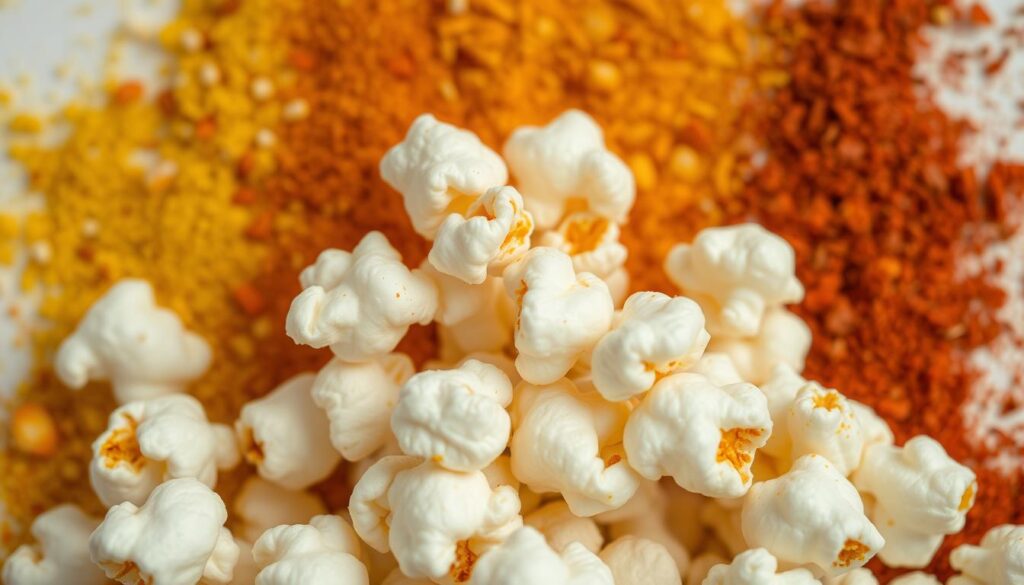

Today, popcorn is still a favorite snack. The Midwestern United States grows most of the corn used for popping. Food scientists keep finding new ways to make popcorn better, keeping it a hit with fans of Cultural Gastronomy, Traditional Recipes, and Historical Foodways.
The Intriguing Story Behind Ice Cream
The story of ice cream starts with ancient civilizations. They enjoyed frozen treats, especially the rich. Over time, these icy delights evolved in Europe, showing how food culture changes.
The Origins of Frozen Treats
The first ice cream in the New World was mentioned in 1744. By 1777, it was available almost daily in New York. President George Washington even spent $200 on it in 1790.
Ice cream became more common over time. The 1800s saw the rise of insulated ice houses. In 1851, Jacob Fussell started the American ice cream industry in Baltimore.
Innovations in Ice Cream Production
Technology has greatly changed ice cream making. Nancy Johnson created the first hand-cranked freezer in 1843. Later, Clarence Vogt made a continuous freezer in 1926.
Now, the U.S. makes over 6.4 billion pounds of ice cream a year. People eat more than 20 quarts each after World War II. Ice cream is loved everywhere, from old soda fountains to today’s stores.
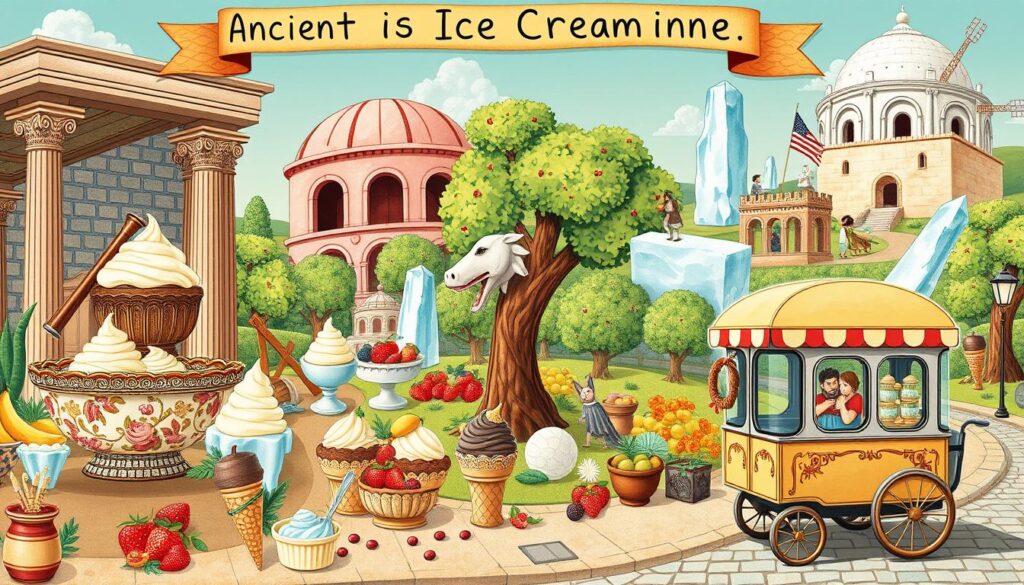

The Legacy of Gummy Bears
Gummy bears are a favorite candy for people of all ages. They have a rich history that spans continents and generations. These chewy, fruit-flavored treats started in a small candy shop in Bonn, Germany in the 1920s.
From Germany to Global Sensation
In 1922, Hans Riegel Sr. created gummy bears for his Haribo company. He was inspired by the trained bears he saw at festivals. Riegel mixed gelatin, starch, and sugar to make bear shapes, called “Dancing Bears.”
By the 1980s, gummy bears became famous worldwide. Haribo brought their Goldbären to America in 1982. The public loved their chewy texture and fruit flavors, leading to many imitations.
The Science Behind Gummy Candy
Gummy bears’ appeal comes from their texture and flavors. Gelatin, from animal bones, is key. It mixes with sugar and starch to create their chewy, jiggly feel.
Today, gummy bears come in many shapes and flavors. They’ve grown from bears to sharks, peach rings, and more. Their lasting popularity shows they’re a favorite treat for many.
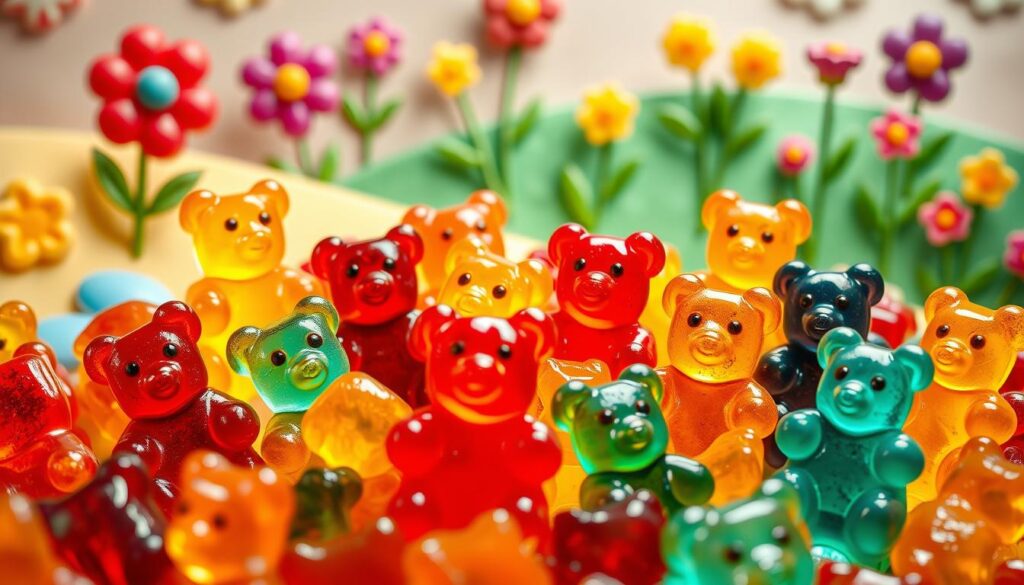

“Gummy bears have become a cultural icon, appearing frequently in popular media and showcasing their universal appeal.”
Gummy bears have come a long way from their German roots. They are now a big part of Food History, Culinary Origins, and Gastronomic Evolution. Their legacy continues to bring joy to people everywhere.
The Culinary History of Pretzels
The pretzel has a long and interesting history. It started in European monasteries around 610 AD. The pretzel shape is like folded arms in prayer.
As pretzels spread, they became a big part of German baking.
A Twist on Tradition: Origins of Pretzels
The pretzel, or “Brezel” in German, might have come from Roman unleavened bread. By the 12th century, it was a key part of German baking. In the 17th century, pretzels were used in Switzerland wedding ceremonies.
This might have started the phrase “tying the knot.”
Pretzels in Different Cultures
- German immigrants brought pretzels to America around 1710. Julius Sturgis started one of the first pretzel bakeries in Pennsylvania in 1861.
- In the 16th century, pretzels were given to kids who learned their prayers. This shows their deep culinary heritage.
- Today, pretzels are loved all over the world. They come in many types, from soft to crispy. They’re often eaten with German mustard and other toppings.
Now, pretzels are a beloved food in Germany. They’re known worldwide as a special ethnic cuisine and traditional recipe.
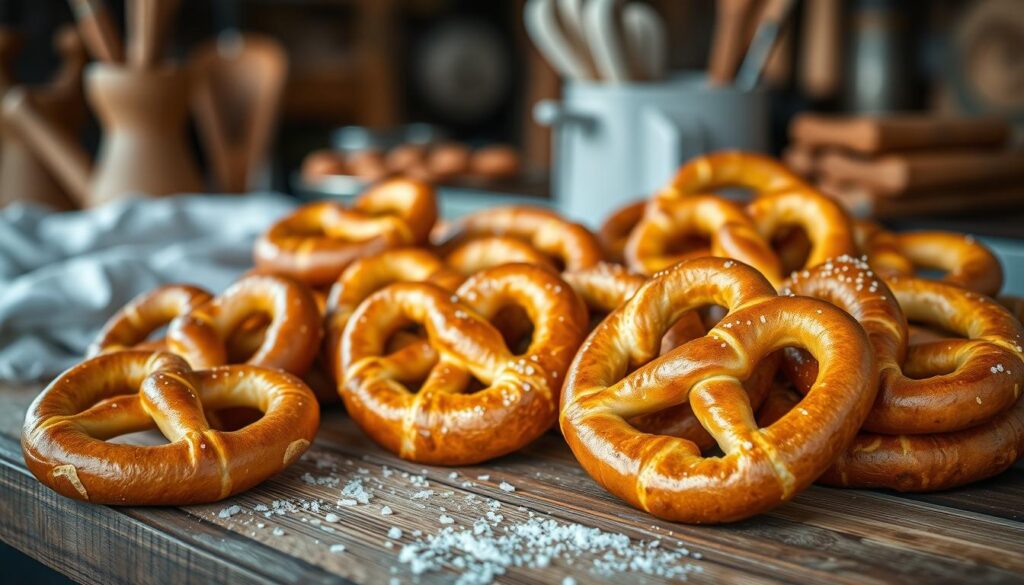

The Rise of the Granola Bar
In the world of Food History and Gastronomic Evolution, the granola bar is a key player. It shows how Flavor Narratives can change the food scene. Granola, the main ingredient, was first made by Dr. James Caleb Jackson in 1863 as a health food.
But it wasn’t until the 1970s, with more people caring about health, that the modern granola bar came to be. Stanley Mason is often credited with its creation, but Herrick Kimball also claims to have made the first commercial version. Big brands like Quaker Oats and General Mills made granola bars popular in the 1980s.
They introduced many flavors and types, from chewy to crunchy. These included nuts, fruits, and chocolate.
Health Trends and Snack Evolution
The rise of the granola bar matched a trend towards healthier snacks. In 2014, Mintel said the market wanted healthier foods, which helped some brands but hurt others. The industry then struggled to innovate, affecting the bar market.
Major Brands that Popularized Granola
- Quaker Oats: This iconic brand introduced and made granola bars popular, offering many flavors and textures.
- General Mills: As another big name, General Mills helped make granola bars common, adding to the market with their own products.
- Bobo’s: This small, artisanal brand grew fast, reaching $9 million in sales in 13 years. Then, with T.J. McIntyre, they almost tripled their revenue to $22 million in less than three years.
The granola bar industry keeps growing, with estimates of a $5 billion global market. It’s a big part of the $25 million to $70 million energy gels and chews market. As people look for easy and healthy snacks, the stories around granola bars will keep changing the food world.
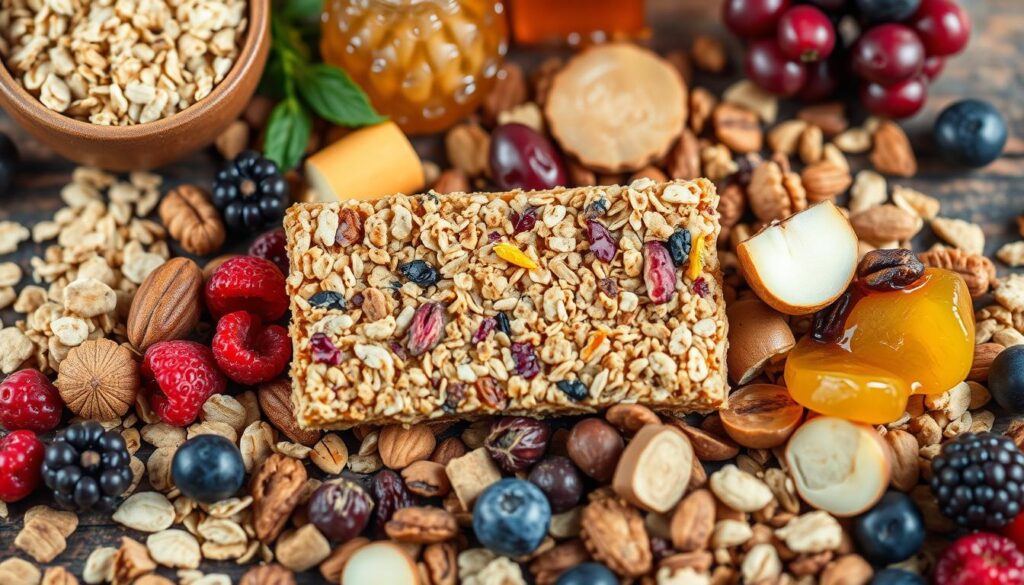

The Curious Case of Energy Drinks
The rise of energy drinks in Food Anthropology is fascinating. They started in the 1960s in Japan with Lipovitan-D. Then, Red Bull launched in Austria in 1987 and hit the US in 1997. This success led to many more brands entering the market.
Timing and Trends: The Energy Drink Boom
Energy drinks became very popular quickly. Red Bull was the first, and soon Monster Energy (1997), Rockstar Energy (2001), and 5-hour Energy (2004) followed. Each brought their own mix and marketing to attract more people.
Ingredients That Fuel Your Day
Energy drinks mix caffeine, taurine, B-vitamins, and sugar or sweeteners. They aim to give a quick energy boost for today’s fast-paced lives. But, they’ve faced criticism for their caffeine and sugar levels. This has led to the creation of “natural” and sugar-free options.
“The rise of organic and natural energy drinks in 2012 saw brands like Scheckter’s Organic Energy, Runa Clean Energy, and Guru appealing to health-conscious consumers.”
The story of energy drinks is still unfolding. It’s a fascinating area of study, with new developments and trends shaping the market.
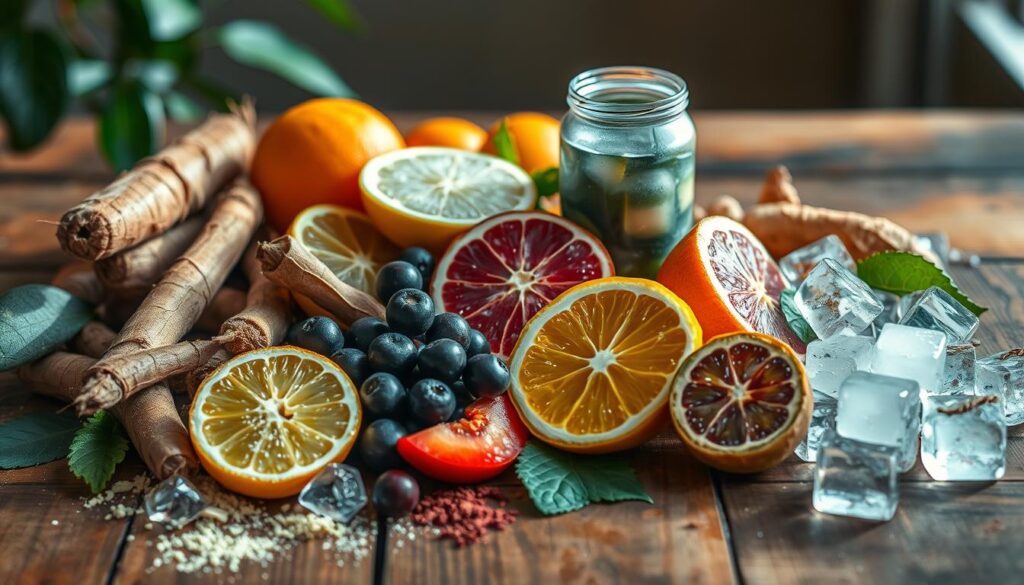

The Saga of Cheese Puffs
The cheese puff has a rich Food History that started in the 1930s in Wisconsin. The Flakall Corporation was working on a corn cleaner when they found a way to puff up corn kernels. This led to the first puffed snack, later improved by the Elmer Candy Corporation into Korn Kurls.
In 1948, the Frito Company made cheese puffs even more popular with Cheetos. They added a cheesy flavor to the puffed corn, making a snack that people love. Cheetos’ bright orange color and crunchy texture have made them famous worldwide.
From being an accident to becoming a favorite snack, cheese puffs show the power of Food History, Culinary Origins, and changing Flavor Narratives.
Origins of Puffed Snacks
The story of cheese puffs begins in the 1930s in Wisconsin. The Flakall Corporation was making a corn cleaner. They found that heated, moistened corn kernels puffed up, creating the first puffed snack.
Brand Innovations in Cheese Flavors
The Elmer Candy Corporation later made the puffed corn product, now called Korn Kurls. But it was the Frito Company that introduced Cheetos in 1948. They added a tasty cheese flavor to the snack. This led to many cheese puff variations and brands, making cheese puffs a favorite snack.
“The distinctive orange color and crunchy texture of cheese puffs have made them a snack beloved worldwide.”
The Tale of M&M’s
M&M’s chocolate candies have won the hearts and taste buds of Americans for many years. Forrest Mars Sr. and Bruce Murrie created them in 1941. These candies were inspired by chocolate pellets eaten by soldiers in the Spanish Civil War.
First sold to the U.S. military, M&M’s hit the public in 1947. They quickly became a favorite.
The Creation of the Iconic Candy
In 1940, Forrest Mars Sr., son of Frank C. Mars, started M&M’ Limited in Newark, New Jersey. He introduced M&M’S Plain Chocolate Candies. This new candy had a hard, colorful shell and a smooth chocolate center.
This design was inspired by chocolate pellets used by soldiers. It made sure the candies would “melt in your mouth, not in your hand.”
M&M’s Role in Marketing and Culture
Over the years, M&M’s have grown beyond just a candy. They’ve become a cultural icon. The brand has added many flavors and colors, including the famous red ones.
In the 1970s, red M&M’s were removed due to a food dye scare. But they returned. M&M’s even went to space in 1981, becoming the first candy in NASA’s space shuttle mission.
Today, M&M’s keep winning hearts with new marketing, mascots, and a global reach. They are a key part of Food History, Culinary Heritage, and Gastronomic Evolution.
Source Links
- https://amazingfoodanddrink.com/most-popular-foods-origins/
- https://listverse.com/2019/08/13/10-bizarre-origin-stories-about-your-favorite-foods/
- https://www.lovefood.com/gallerylist/128759/killer-tomatoes-and-other-strange-historic-food-facts
- https://www.history.com/news/who-invented-potato-chip-saratoga
- https://www.foxnews.com/food-drink/the-surprising-history-of-potato-chips
- https://www.mashed.com/124850/the-strange-history-of-potato-chips/
- https://www.history.com/topics/ancient-americas/history-of-chocolate
- https://www.yummycomb.com/chocolate-bar-history-a-timeline-of-sweet-evolution/
- https://www.historyoasis.com/tags/soda-pop
- https://www.iheart.com/podcast/1119-stuff-you-should-know-26940277/episode/the-amazing-history-of-soda-29467420/
- https://drinkolipop.com/blogs/digest/history-of-soda-in-popular-culture?srsltid=AfmBOorHDVjnOoA8vDJ7qFUprQSOkhKGksMJyl0hlCimrgvwE_bj0P3t
- https://en.wikipedia.org/wiki/Popcorn
- https://medium.com/@Bernard_Koh/pop-goes-the-culture-a-social-and-scientific-history-of-popcorn-6b8198f5b100
- https://whatscookingamerica.net/history/popcornhistory.htm
- https://www.idfa.org/the-history-of-ice-cream
- https://www.history.com/news/where-do-ice-cream-sorbet-frozen-desserts-come-from
- https://candypros.com/pages/history-of-gummy-bears?srsltid=AfmBOopnaTuodQit7MSZhdNnNA1cDMvL8-FTHcFXiXNsCTzbsCKM4W0b
- https://www.mentalfloss.com/posts/gummy-bears-food-history
- https://classx.org/food-history-gummy-bears/
- https://www.history.com/news/the-pretzel-a-twisted-history
- https://www.oldworldhb.com/history-pretzel/
- https://sciencemeetsfood.org/current-food-trends-rescued-snack-bar/
- https://www.outsideonline.com/health/nutrition/snackification-american-diet/
- https://www.historyoasis.com/tags/energy-drinks
- https://www.nutraingredients.com/Article/2015/11/09/the-curious-case-of-energy-drinks-hypokalemia
- https://www.nola.com/entertainment_life/twisty-crunchy-cheewees-created-in-1936-at-elmers-on-magazine-st-hold-a-place-in/article_b43e6252-5929-11ed-adb8-a7d7d4be1725.html
- https://www.heraldweekly.com/favorite-food-drink-items-that-were-actually-invented-by-accident/5
- https://www.foodtimeline.org/foodfaq.html
- https://www.history.com/news/the-wartime-origins-of-the-mm
- https://www.mms.com/en-at/explore/about-us
